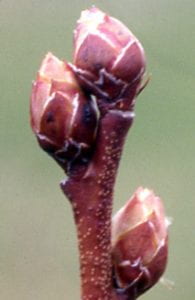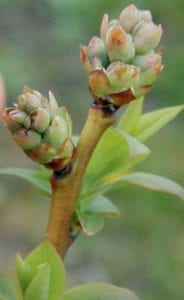Blueberries and strawberries in most parts of the state are beginning the process of growing new leaves and initiating flower maturation. To prevent crop loss during cold snaps, it is helpful to understand critical temperatures for crop injury and some approaches to protect the crop from frosts and freezes.
Blueberries
Most blueberry plants are between the stages of bud swell and tight cluster. At bud swell, the crop is hardy to 10 – 15˚F (-12 – -9˚C).

At tight cluster, the crop is hardy to temperatures between 20 – 23˚F (-7 – -5˚C).

Strawberries
A large portion of the New York strawberry crop has begun to de-acclimatize from winter and will benefit greatly from having access to sunlight during bouts of mild weather—the sunlight will help the plants increase their carbon stores, creating more available energy for cold damage recovery in the crown, as well as sugar synthesis. However, as the flower buds emerge from the crown, this year’s first crop becomes more and more susceptible to cold damage. Strawberries are not completely able to compensate yield losses if flowers are killed by frost. Thus, protecting the flower buds from cold will produce a larger crop this year.
When strawberry plants are dormant, the flower buds, which are hidden inside of the crown, are hardy to roughly 10 ˚F (-12 ˚C).
At this point, many plants under mulch have begun to exit dormancy due to the warm weather. Even as the flower buds are still in the crown and the plant is only pushing new leaves, the cold tolerance of the strawberry plant has decreased to approximately 15˚F (-9.5˚C).
Once the tightly closed flower buds become visible as they emerge from the crown, the cold tolerance drops to 20 – 25 ˚F (-6˚C – -4˚C).
Cold and frost protection strategies
When a dip below the critical temperature is predicted, it is best to apply frost protection before the cold temperatures are reached on your site, so that residual heat is trapped to buffer the crop from the cold.
Two layers of floating row cover can offer long-term frost protection to strawberries or blueberries as it allows the plants to photosynthesize, but the daytime heat this material traps will also push development further along than having the plants exposed to the ambient air temperature.
Overhead irrigation, either directly over the crop or on top of the floating row cover, can be a great asset if done correctly. However, at this point in the season, correctly using irrigation for frost protection is a challenge due to the long duration of our cold periods. Before using irrigation as a frost protection measure, it’s critical to have enough water available to irrigate for the entire duration of the cold snap. In addition, as wind speeds increase, the volume of water required increases as well. It is not worth using overhead irrigation if wind speeds are greater than 8 miles per hour.
At this time of year, as the plants are in early stages of waking up and we have multi-day cold periods, I’d recommend covering the crop with straw and/or several layers of floating row cover. It is also a good time to check the status of the overhead irrigation system and ensure that there are no clogs or leaks, for use later in the spring.
References
Critical Spring Temperatures in Blueberries | Anonymous, Michigan State University | link
Strawberry Cold Protection 101 | Mark Hoffman, NC State University| link
Blueberry Freeze Protection (Video) | Bill Cline, University of Arkansas Extension | link
